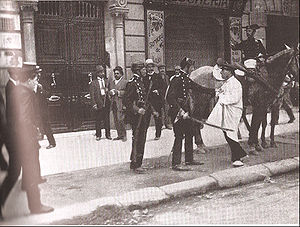You can help expand this article with text translated from the corresponding articles in Spanish and Catalan. (March 2018) Click [show] for important translation instructions.
|
| Tragic Week | |||
|---|---|---|---|
| Part of the Second Rif War | |||
 Suspects rounded up by the Civil Guard. | |||
| Date | 26 July – 2 August 1909 | ||
| Location | |||
| Caused by | Opposition to conscription and the Second Rif War Antimilitarism Anti-clericalism | ||
| Methods | Rioting, strikes, barricades, arson and murder | ||
| Parties | |||
| Casualties and losses | |||
| Arrests: 1,700 Injuries: 441[1] Deaths: 104 to 150 civilians and 8 military. Five further civilians were executed after the riots. | |||
Tragic Week (in Catalan la Setmana Tràgica, in Spanish la Semana Trágica) (25 July – 2 August 1909) was a series of violent confrontations between the Spanish army and anarchists, freemasons, socialists and republicans of Barcelona and other cities in Catalonia, Spain, during the last week of July 1909. It was caused by the calling-up of reserve troops by Premier Antonio Maura to be sent as reinforcements when Spain renewed military-colonial activity in Morocco on 9 July, in what is known as the Second Rif War. Many of these reservists were the only breadwinners for their families, while the wealthy were able to hire substitutes. The figureheads most associated with the unrest were Alejandro Lerroux and Francisco Ferrer.
- ^ Dalmau, A. (2009). Set dies de fúria: Barcelona i la Setmana Trágica. Columna. pp. 59-60.